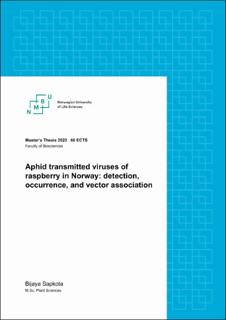| dc.description.abstract | Raspberry (Rubus idaeus L.) is the high value horticultural crop, which is susceptible to multiple viruses, including aphid borne viruses, that lead to yield loss. Thus, proper identification of relevant viruses and their possible vector is essential to reduce disease and loss.
Symptomatic samples of red raspberries including aphid samples from three different counties (Vestland, Agder and Viken) of Norway were analyzed for the presence of four important aphid-transmitted raspberry viruses: black raspberry necrosis virus (BRNV), raspberry leaf mottle virus (RLMV), raspberry vein chlorosis virus (RVCV) and rubus yellow net virus (RYNV). Altogether, 95 leaf samples and 31 aphid samples from three main cultivated cultivars (Glen Ample, Glen Mor and Veten) and samples of wild raspberry plants were tested by RT-PCR, using virus-specific primers. BRNV was the most prevalent virus in leaf samples in all counties, comprising 89% of infection followed by RLMV (28%) and RVCV (8%). BRNV and RVCV were found in all selected counties, but RLMV was detected only in Vestland. The obtained result showed a high proportion of mixed infections, the most common involving BRNV and RLMV (24.3%), followed by the mixed infection of BRNV and RVCV (1.4%). Furthermore, all 3 main cultivars and samples of wild species of raspberry were detected with at least one of the viruses mentioned. Apart from this, 13 out of 31 aphid samples which include both Amphorophora (Am.) idaei and Aphis (Ap.) idaei. were found infectious with BRNV and RLMV.
For the first time, BRNV and RLMV were detected in Ap. idaei. So, to gather more information in biology of this aphid species and its role in BRNV transmission, virus free Ap. idaei were reared in culture rooms of NIBIO and were transferred to virus free raspberry plants using different acquisition and inoculation time periods. Ap. idaei acquired BRNV after at least one hour and lose it after at least five hours of starvation. However, the transmission of BRNV by Ap. idaei was not proven. This thesis will contribute to a better understanding of virus diseases and their vectors in raspberry production in Norway. | en_US |

